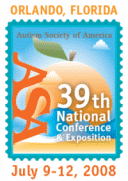 |
The ASA's 39th National Conference on Autism Spectrum Disorders of ASAThe Westin Kierland Resort & Spa, Scottsdale, AZ |
| For a complete author index with session numbers, please click here | |
| Friday, July 11, 2008: 10:45 AM-12:00 PM | |||
| Sarasota 2 | |||
| #3403- The LINK Program – A Peer to Peer Support for Students with Autism Spectrum Disorder | |||
| This presentation will provide information on a peer to peer support program for students with Autism Spectrum Disorder (ASD). The program includes a unique set of components that allow for social learning and growth for both general education students and students with ASD. This presentation will provide information on the steps and processes needed to construct a peer to peer support program as well as successful strategies that allow students with ASD opportunities to learn in the least restrictive environment. | |||
| Presenters: | - Maureen Ziegler, Ed.S., Autism Intervention Specialist, Grand Valley State University, will be presenting information on the LINK Program, which is a peer to peer support system for students with autism spectrum disorders.
- Kelly Dunlap is a school psychologist / positive behavior support consultant who has worked on the START project for 6 years. | ||
|
| |||
|
This presentation provides specific information on one school district’s peer to peer support program (LINK) for kindergarten through post-high school students with Autism Spectrum Disorder (ASD). The program has been in existence for 20 years and provides a unique set of programming components that allow for general education participation and individual growth in communication, socialization and independence for students with ASD. This presentation will provide the chronological development of the program including the transition from segregation to inclusion and the philosophical departures and mechanical processes necessary for successful implementation of the program including issues related to social learning. Beliefs about social growth and opportunity needed to sustain the program also will be addressed along with actual strategies that provide social learning for students with ASD. Essentially, there are two primary ways to address the socialization skill deficits for students with ASD. The traditional paradigm is to utilize a social skills curriculum to teach isolated social skills in isolated settings and then practice those skills in a generalized setting. The LINK program is unique in that it focuses on providing general education students with information about students with ASD and building tolerance, understanding, and acceptance of students with ASD within the general education population. Students with ASD then have multiple opportunities to practice age-appropriate social skills in all settings across their day; thus, gaining social competency in natural environments. The LINK program involves having general education peers function as peer supports for students with ASD throughout the school day. Students with ASD observe and learn typical social, communication, behavior, and academic skills through the modeling and participation of general education peers. The LINK curriculum, founded in the Michigan Curriculum Framework, forms the academic foundation of such planned student-to-student interactions, and benefits typical students and students with ASD in a reciprocal manner. The LINK student learns, through participation in the curriculum, to act as an advocate and mentor for a student with a disability as they master content standards. The interactive nature of instruction enables the LINK student to consistently broaden the range of opportunities for the student who has a disability as well. The LINK program also focuses on integration opportunities for students with ASD. Two concepts outlined by the Individuals with Disabilities Education Act Amendments of 1997, Least Restrictive Environment (LRE) and access to the general education curriculum, have important implications for inclusion practices for student with disabilities (Turnbull et al., 2003). LRE refers to provisions requiring that students with disabilities are appropriately supported in settings with non-disabled peers to the “maximum extent appropriate,” a subject that has met with intensive debate (Howard, 2004). More recently, mandates from the Individuals with Disabilities Education Improvement Act of 2004 (20 U.S.C. 1400), have further encouraged the inclusion of students with disabilities in general education settings. Collectively then, legal support for inclusion is quite strong. |
|||
See more of General Submissions
See more of The ASA's 39th National Conference on Autism Spectrum Disorders